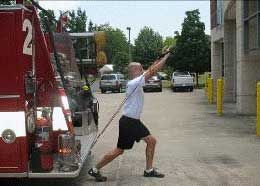By Bryan Fass
 A reaction ball. |
One of the most common questions I receive is how to stay fit on duty, specifically while in uniform. Budgets of most agencies continue to get slashed, gear gets more expensive, and the amount of money being allotted for exercise equipment and physical testing is diminishing.
However, effective fitness and wellness is surprisingly inexpensive and really requires very little space. One of the greatest benefits of the EMS profession is that when there is down time, you can essentially get paid to exercise.
There are a myriad of inexpensive exercise ‘toys’ that you can carry in your gear bag or have in each station to make the time in between calls fun and healthy. A reaction ball — or tennis/racquet ball — and a resistance band are the only tools you need to keep fitness fun and portable.
A simple game of wall ball, taken from back in the elementary school days, will burn calories and increase agility, reaction time and balance. The side of a building is perfect for you and your partner to play. You can make the game as easy or hard as you want by altering your distance from the wall, not moving until the ball bounces on the ground one time, or even adding a “punishment” for dropping or missing the ball. Body weight squats, push ups or a quick sprint can be great ways to turn up the intensity. Adding in a reaction ball makes the game more dynamic and fun.
Another simple way to exercise while on duty is to use a resistance band. Just secure the band on the grab bars of the truck by wrapping it around the bar, and then you will be able to perform rows, pulls, presses, squats, lunges and balance/abdominal movements in the standing position. We spend way too much time sitting on our butts, so let’s not make the same mistake and exercise that way!
Another benefit to the resistance band is that you can include your partner by acting as the “tether” for the band. Both of you are getting a workout by using this natural resistance method. The person that is acting as the tether must stabilize themselves against the force the other person is producing. This requires the tether’s knees to be bent and the abdominal wall to be engaged, all while presenting a challenging balance exercise.
Other simple ways to add fitness and wellness exercises while on duty can be simple activities like climbing stairs or doing laps around the station for a set duration. A repetition of “step ups” on the skid plate of your truck work well too. If you want to increase the intensity, add all the activities together. Play wall ball for five minutes, do three sets of band rows for 15 repetitions, and then do 20 step ups. Do this for five cycles, changing the band exercises for each time through the cycle.
Over the course of my clinical career, I have noticed people do two very predictable and deleterious things when approaching exercise. Make sure to avoid these traps:
- People tend to revert back to old habits that contributed to their unfit state. The definition of insanity is doing the same thing again and again and expecting a different result. Crunches, leg raises, bench presses, back extensions, and other common repetitious exercises do not work! In fact, they can actually harm you.
- People tend to make a simple exercise or stretch overly complicated. Make all your movements controlled and specific. Your joints can only move so far; do not try to get extra pull or squeeze if it’s not there. For example, the row is a simple movement that involves pulling the resistance band back until your hands are at the sides of your chest. People tend to pull too far, which leads to leaning back, shrugging the shoulders, and flexing the wrists. All you need to do is gently and consistently squeeze the shoulder blades together.
As I hope you can now see, being fit on duty is really not that hard and takes minimal time and very little equipment. Integrating safe and effective exercises into your shift does not have to be complicated in order to be immensely effective. Public safety is very hard on the body, so it’s up to you to be fit and strong, and have a little bit of fun doing it along the way.
 Row |  Chest press |
 Overhead press |  Squat/Row |
 Photos by Bryan Fass Pull down |












